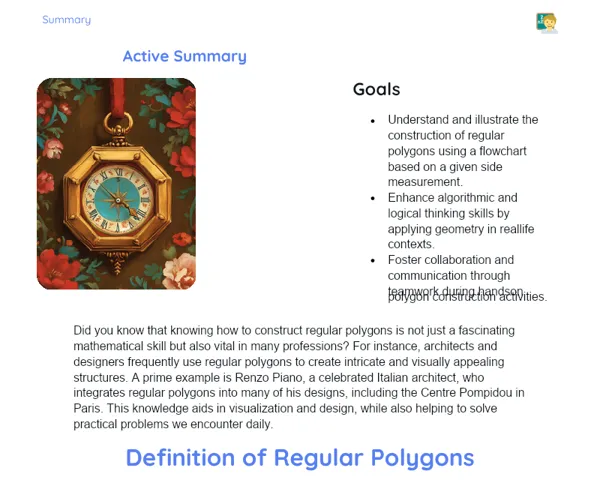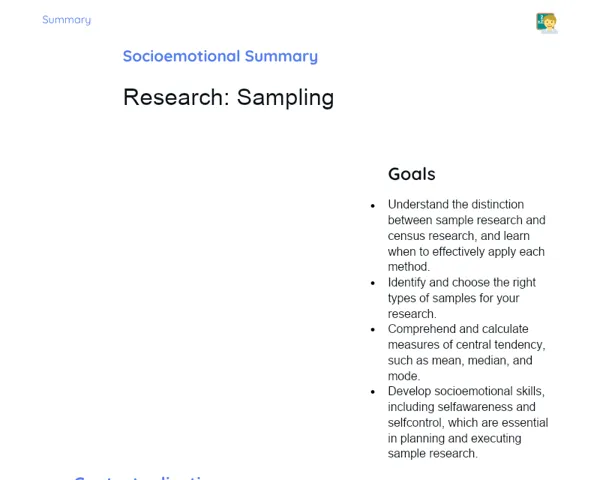Summary Tradisional | Spatial Geometry: Surface Area of the Sphere
Contextualization
Spatial geometry is a vital area of mathematics that focuses on understanding three-dimensional figures. Among these, the sphere is unique due to its perfect symmetry, being a three-dimensional object with no edges or vertices, where every point on its surface is equidistant from the center. Knowing how to calculate the surface area of a sphere is crucial in various practical fields, such as engineering, where it's important for designing spherical objects, and even in astronomy, where it helps us determine the area of planets and stars.
In this lesson, we will concentrate on the formula for the surface area of a sphere, A = 4πr², where 'A' denotes the surface area and 'r' represents the sphere's radius. We'll also discuss related topics, including the spherical cap and cup, which are sections of the sphere's surface created by intersecting it with a plane. Through relatable examples, such as working out the surface area of a cricket ball, students will apply these ideas and enhance their skills in tackling geometric problems not only in academics but also in everyday situations and future careers.
To Remember!
Definition of Sphere
A sphere is a three-dimensional geometric figure that possesses perfect symmetry in all directions. It is defined by the absence of edges or vertices, with every point on its surface equidistant from a point known as the center. Common examples of spheres include cricket balls, globes, and even bubbles.
Visualize the sphere as a multitude of tiny circles radiating out from its center. This radial symmetry is one of the intriguing features that render the sphere significant across various scientific and engineering fields. Moreover, the sphere has the smallest possible surface area for a given volume, making it an efficient shape for storage and construction.
In spatial geometry studies, understanding the sphere is foundational for exploring more complex three-dimensional shapes. Knowing its basic properties, including surface area and volume, is essential for addressing more intricate problems and applying these concepts in real-life scenarios.
-
The sphere is three-dimensional and symmetrical in all directions.
-
All points on the surface of a sphere are equidistant from the center.
-
The sphere has the smallest possible surface area for a given volume.
Surface Area Formula of the Sphere
The formula for determining the surface area of a sphere is A = 4πr², where 'A' indicates the surface area and 'r' signifies the radius of the sphere. This formula arises from integral calculus and is crucial for addressing issues involving spheres in diverse fields like engineering, physics, and astronomy.
This formula originates from the aggregation of infinitely small areas that constitute the sphere's surface. By integrating these minute areas across the sphere, we arrive at A = 4πr². It's a formula that is both elegant and easy to use, allowing for quick calculations of surface areas of spheres when the radius is known.
Grasping and utilizing this formula is significant for solving practical challenges. For instance, when creating a cricket ball, the surface area informs the quantity of materials required. Similarly, in astronomy, this formula helps compute the area of planets and stars, which is vital for studies related to radiation and energy emission.
-
The formula for the surface area of a sphere is A = 4πr².
-
The formula derives from integral calculus.
-
Applying the formula aids in solving practical issues in engineering, physics, and astronomy.
Spherical Cap
A spherical cap is a section of a sphere's surface that is sliced by a plane. Imagine a sphere being bisected by a plane; each of the resulting sections is a spherical cap. This concept is crucial for calculating the area of spherical segments rather than full spheres.
The formula for determining the area of a spherical cap depends on both the height of the cap and the radius of the original sphere. In various practical scenarios, like the design of domes or cut spherical containers, calculating this area is essential to ascertain the material needed and consider other design requirements.
Grasping the idea of the spherical cap and its corresponding formula is a natural progression in understanding spheres. Learning to compute the area of a cap empowers students to address more complicated and real-world problems, linking geometric principles with everyday applications in multiple professions.
-
A spherical cap is a portion of a sphere's surface created by slicing with a plane.
-
The formula for the area of a spherical cap varies based on the cap's height and the sphere's radius.
-
Spherical caps are significant in the design and production of domes and sliced spherical containers.
Practical Applications
Knowledge of the surface area of a sphere has various real-world applications across different domains. For example, in engineering, being able to calculate this area is fundamental for crafting spherical items such as storage tanks and spherical parts in machinery. In the realm of sports, particularly in designing cricket balls, the surface area impacts the ball's performance and aerodynamics.
In astronomy, this surface area formula is employed to compute the areas of planetary bodies and stars. Such calculations are essential for research concerning radiation and energy output, aiding in understanding astrophysical phenomena and celestial progression. Additionally, in healthcare, spherical geometry can play a role in designing prosthetics and medical devices that adopt spherical or semi-spherical shapes.
These practical usages illustrate the importance of geometric concepts in our real lives. By mastering the calculation of a sphere’s surface area and its variations, students acquire skills valuable in various careers and daily situations, making the study of spatial geometry not just theoretical but also practical and applicable.
-
The surface area of a sphere is vital for designing spherical objects in engineering.
-
In sports, surface area affects the performance of spherical balls.
-
In astronomy, the formula is used to calculate the areas of planets and stars.
Key Terms
-
Sphere: A three-dimensional geometric figure with all points on the surface equidistant from the center.
-
Surface Area: A measurement of the total extent of a three-dimensional object's surface.
-
Formula A = 4πr²: The formula utilized to calculate a sphere's surface area.
-
Spherical Cap: A part of a sphere's surface created by slicing it with a plane.
-
Cup: A spherical cap with a flat base, used as a container in specific scenarios.
Important Conclusions
In this lesson, we delved into spatial geometry, focusing on the surface area of a sphere and its related concepts, including spherical caps. We initiated our study by defining the sphere and discussing its characteristics, highlighting its symmetry and the important formula A = 4πr² for measuring surface area. We then explored the concept of a spherical cap, detailing how to compute the area of particular sections of a sphere, with practical examples to elucidate the application of these concepts in the real world.
We underscored the significance of comprehending the sphere's surface area given its diverse practical uses, from designing cricket balls to conducting astronomical studies and engineering tasks. This knowledge is vital for navigating complex problems and creating effective solutions across numerous fields. Through exercises and discussions on queries, students were enabled to connect theory with actual scenarios, solidifying their understanding.
Finally, we highlighted the topic's relevance for students' academic and professional development. Mastering spatial geometry and the surface area of spheres and spherical caps is a skill that can be applied widely. We encourage students to pursue further exploration on this topic, deepening their understanding and seeking new practical uses for the concepts acquired.
Study Tips
-
Review the formula A = 4πr² and practice applying it to various problems. Familiarity with the formula will bolster comprehension.
-
Study practical examples and tackle additional problems involving spherical caps and other three-dimensional figures to enhance problem-solving confidence.
-
Look into extra resources, such as educational videos and online materials, that provide detailed explanations and fresh insights on the subject.



